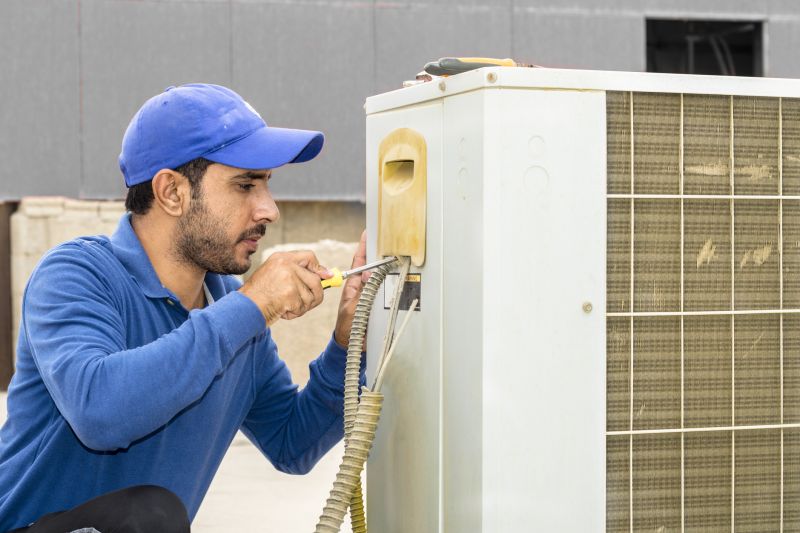Leading HVAC Replacement Solutions To Upgrade Your System
Browse top-rated replacement products that help modernize your HVAC setup for better energy use and comfort.
 Replacing components within an HVAC system requires careful selection of compatible and reliable products to ensure optimal performance and longevity. When considering replacements, it's important to evaluate the specific needs of your system, such as size, capacity, and compatibility with existing equipment. Whether upgrading a furnace, air conditioner, or ventilation parts, choosing the right products can help maintain consistent indoor comfort and efficiency. The variety of available options includes essential components like filters, thermostats, motors, and ductwork, each playing a vital role in the overall functionality of the HVAC system.
Replacing components within an HVAC system requires careful selection of compatible and reliable products to ensure optimal performance and longevity. When considering replacements, it's important to evaluate the specific needs of your system, such as size, capacity, and compatibility with existing equipment. Whether upgrading a furnace, air conditioner, or ventilation parts, choosing the right products can help maintain consistent indoor comfort and efficiency. The variety of available options includes essential components like filters, thermostats, motors, and ductwork, each playing a vital role in the overall functionality of the HVAC system.
Top Overall Option
Universal HVAC Replacement Kit
A comprehensive replacement kit designed to include a variety of essential components such as filters, thermostats, and control boards, suitable for multiple HVAC system types. It offers versatility and ease of installation, making it a popular choice for both professionals and DIY enthusiasts seeking a reliable set of parts to address common replacement needs.
Types of Products For Hvac Replacements
Air Filters
Filters that trap dust, pollen, and other airborne particles to improve indoor air quality and protect system components.
Thermostats
Devices that regulate temperature settings and can include programmable or smart features for enhanced control.
Blower Motors
Motors that drive the fan to circulate air through the system, essential for proper airflow.
Contactor Relays
Electrical components that control the power supply to compressors and fans, crucial for system operation.
Capacitors
Components that help start and run motors efficiently, often replaced during system upgrades.
Evaporator Coils
Coils that absorb heat from indoor air, playing a key role in cooling cycles.
Condenser Coils
Exterior coils that release heat from the refrigerant, essential for cooling processes.
Ductwork
Systems of ducts that distribute conditioned air throughout the building.
Expansion Valves
Components that control refrigerant flow into the evaporator coil, vital for cooling efficiency.
Furnace Burners
Parts that ignite fuel in heating systems, critical for proper combustion.
Air Handlers
Units that contain fans and filters to circulate and condition air within the system.
Thermal Expansion Valves
Valves that regulate refrigerant flow, ensuring optimal cooling performance.
Pressure Switches
Safety devices that monitor system pressure and prevent damage from overpressure conditions.
Humidifiers
Devices that add moisture to the air, improving indoor comfort during dry seasons.
Dehumidifiers
Equipment that reduces excess moisture in the air, helping to control humidity levels.
Popular Choices
Widely used for maintaining indoor air quality and protecting system components.
Trending for their ability to customize temperature schedules and improve energy management.
Commonly replaced components that support motor operation and system efficiency.
Frequently replaced to maintain proper airflow and system performance.
Popular for improving airflow efficiency and reducing energy loss.
Essential for upgrading or replacing thermostat connections easily.
Important for system cooling cycles, often replaced during repairs or upgrades.
Trending for their role in optimizing refrigerant flow and cooling efficiency.
Popular for improving airflow distribution and aesthetic appearance.
Frequently replaced components that ensure reliable ignition in heating systems.
In demand for accurate temperature regulation and system responsiveness.
Popular for their role in maintaining desired humidity levels.
Trending options for enhancing indoor air quality and reducing pollutants.
Modern HVAC replacement products are designed to be straightforward to install, often with features that facilitate maintenance and troubleshooting. Many products come with detailed specifications and installation guides to assist both professionals and experienced DIY enthusiasts. Durability and performance are key considerations, as these components are exposed to continuous operation and varying environmental conditions. Selecting high-quality, compatible parts can contribute to the system's reliability and reduce the need for frequent repairs.
It's also beneficial to consider energy efficiency ratings and compatibility with smart home systems when choosing replacement parts. Upgrading certain components can lead to better system performance and potential savings on energy consumption, though these outcomes depend on proper installation and system integration. Consulting with HVAC professionals can provide insights into the most suitable products for your specific setup, ensuring that replacements meet the technical requirements and safety standards.
Overall, the process of selecting products for HVAC replacements involves balancing functionality, durability, compatibility, and cost. By understanding the different types of components available and their roles within the system, homeowners and technicians can make informed decisions that support the longevity and efficiency of their HVAC systems.
Key Buying Considerations
- Compatibility with existing HVAC system specifications and models.
- Material durability and resistance to environmental factors.
- Ease of installation and maintenance requirements.
- Energy efficiency ratings and potential impact on operating costs.
- Size and capacity appropriate for the specific application.
- Compatibility with smart home or automation systems if desired.
- Warranty and support options provided by the manufacturer.
- Availability of replacement parts and accessories.
- Compliance with safety standards and certifications.
- Cost-effectiveness relative to the system's overall performance.
- Reviews and recommendations from trusted sources or professionals.
- Ease of troubleshooting and access for repairs.
- Compatibility with existing ductwork or electrical systems.
- Potential for future upgrades or expansion.
- Environmental considerations, if relevant to system design.
This page contains affiliate links. We may earn a commission if you purchase through these links, at no additional cost to you.
